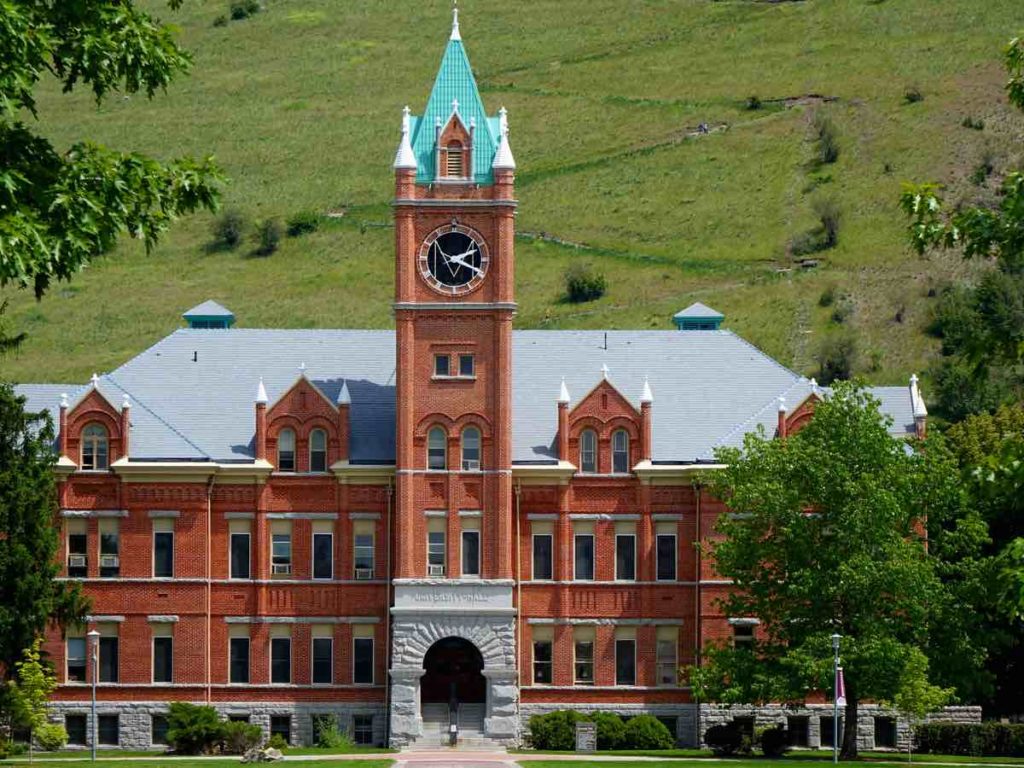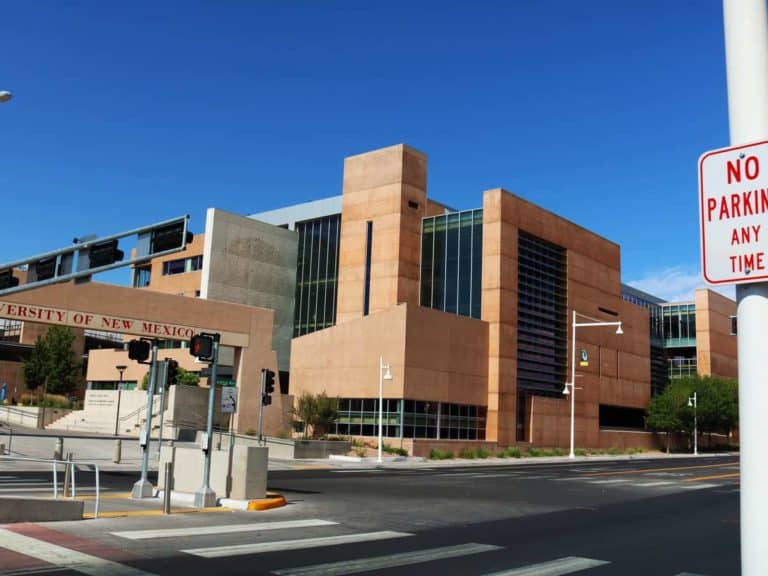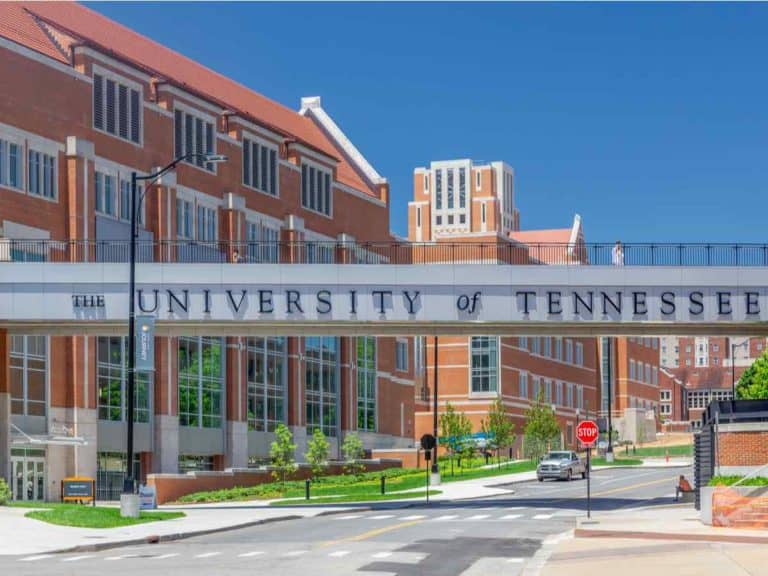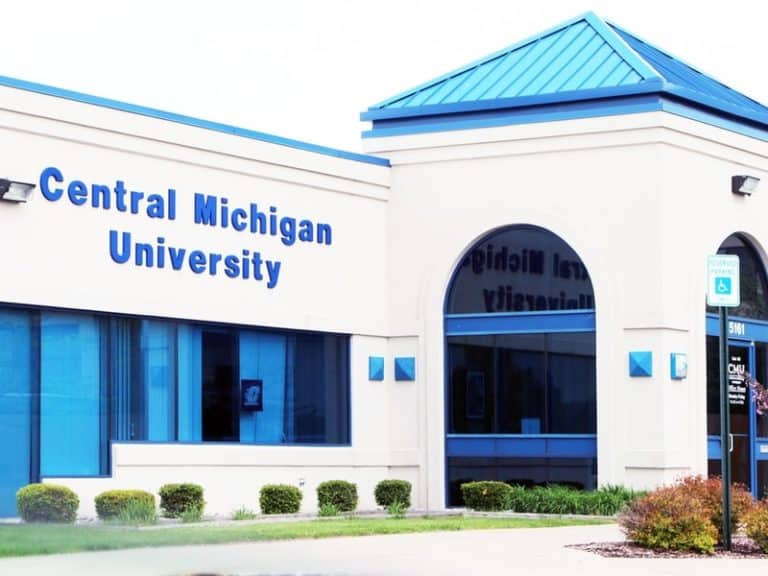Is the University of Montana a Good School?
Flagship universities are major role players in degree production and socioeconomic mobility. They are also some of the largest enrollment-wise, recruiting about one-third of all undergraduate in-state students.
The University of Montana is the flagship campus of the Montana University System.
Located in Missoula, Montana, it’s also a top research institution. In 2022, a Carnegie R1 designation (very high research activity) replaced its former R2 classification.
As such, it’s a good school for research-intensive courses and programs such as business, education, engineering, journalism, and visual and performing arts.
Students who want a fun, lively, and memorable campus experience may also consider it because it’s the second-biggest party school in Montana and offers a decent Greek-letter exposure.
Programs for Traditional and Non-Traditional Students Alike
Up to 95% of applicants often get into UM.
The average GPA of those who enroll is 3.3. It’s a test-optional school, and the SAT and ACT scores of those who submitted theirs during application range from 1080 to 1278 and 19 to 26, respectively.
Similar to most other institutions of higher education, you can apply undecided.
You can earn an online degree or opt for an accelerated program to obtain a bachelor’s degree in just three years.

Apply Undecided/Undeclared or Pick Two Majors at Once
Undergraduate students can choose from nearly 150 majors.
Bachelor’s degree-seeking students can start their UM experience without a major. When they are ready to commit to a major, they need to meet with the academic advisor from the appropriate department.
Here are some of the most popular majors among the undergraduate community:
- Business
- Marketing
- Natural Resources and Conservation
- Social Sciences
- Biological Sciences
- Visual and Performing Arts
- Psychology
- Communication
- Journalism
- Education
At UM, double majoring is allowed.
It means that undergraduate students must fulfill the curricular requirements for both majors.
However, double majoring results in a single bachelor’s degree, not two.
Students who choose two majors across degree classes must declare a primary major. Such will determine the type of degree awarded that will appear on the transcript and diploma.
Complete Accelerated Programs in Just Three Years
It usually takes a minimum of four years to complete a bachelor’s degree.
UM offers undergraduate students to complete theirs in just three years. In other words, accelerated undergraduate degree programs are available, known as Degree in Three Programs.
Unfortunately, the said programs are limited, and they are the following bachelor’s degrees:
- Accounting
- Business Management
- Communication Studies
- Finance
- Management Information Systems
- Marketing
- Psychology
100% Online Programs for High School and College Students
UM has an online campus: UMOnline.
UMOnline offers online programs for both adult learners and high school students. It provides college-level courses for high schoolers, such as dual-enrolled ones for college credit.
Students pursuing an undergraduate degree can choose from 17 online programs, including:
- Anthropology
- Art Studio
- Communication Studies
- Cybersecurity
- Legal Studies
- General Studies
- Library Media Education
- Non-Profit Administration
You can complete the online program of your choice 100% virtually.
In addition, you can work on it at your own pace, keeping your educational needs from getting in the way of your responsibilities.
A support team is available whose members can serve as your online guides and mentors.
UMOnline has accreditation from the Northwest Commission on Colleges and Universities (NWCCU), a US Department of Education-recognized accrediting organization.
Choose From 50+ Countries to Study In
Undergraduates who love to travel and learn can contact the Global Engagement Office.
UM allows students to study in one of more than 50 countries worldwide. It sometimes helps fulfill crucial components of bachelor’s degree programs, such as area studies.
According to UM, these are the top reasons for you to consider studying abroad:
- Grab new opportunities
- Increase your career prospects
- Expand your global awareness
- Make new connections
- Enjoy the chance to travel abroad
Study-abroad programs at UM come in the following sponsored forms:
- Partner Universities
- International Student Exchange Programs (ISEP)
- Faculty-Directed Study Abroad Programs
Which option is best for you will depend on your chosen program and learning and career goals.
Gain Career-Related Experience Through Internships
Waiting to graduate to apply the skills you learned in the classroom in real-world scenarios is unnecessary. That’s because you can do so while still enrolled at UM through an internship.
Many undergraduates take advantage of internship opportunities.
For instance, around 80% of business students participate in at least one internship program. Internship programs at the College of Business happen within one semester, and most of them allow for college credit earning.
Here are the things UM interns get to enjoy:
- Gaining work experience
- Exploration of different career options
- Building a professional network
- Development of one’s resume
- Attainment of personal and professional growth
R1 Stands for Very High Research Activity
In the past, UM had a Carnegie R2 classification.
These days, it brandishes an R1 classification for having very high research activity. As such, it’s an ideal school for students, including undergraduates, looking for research-intensive courses.
The reason?
Research expenditures by the University of Montana dramatically increased in the past few years, from $55 million in fiscal year 2014 to $125 million in fiscal year 2022.
Areas where there’s intensive and excellent research include:
- Biomedicine
- Business
- Education
- Engineering
- Forestry
- Humanities
- Journalism
- Law
- Visual and Performing Arts
UM also has numerous core facilities.
Core facilities are shared, staffed research instrumentation facilities providing state-of-the-art technological services. They serve multiple groups engaged in various research activities.
Some core facilities available include:
- Environmental Biogeochemistry Laboratory
- Fluorescence Cytometry Core
- Inhalation and Pulmonary Physiology Core
- Macromolecular X-Ray Diffraction Facility
- Nuclear Magnetic Resonance Facility
- Statistics and Applied Mathematics Core
Many Small Classes and Enough Faculty for All Students
Around 70% of undergraduate classes at UM have fewer than 30 students. About 89% have less than 50.
Some classes have more than 100 students. The good news is that less than 3% of classes are as jam-packed, and they are mostly courses foundational to a student’s degree.
The student-to-faculty ratio is 16:1.
The National Center for Educational Statistics recommends a 16:1 student-to-faculty ratio for American postsecondary institutions. Based on this, UM’s student-to-faculty ratio is just about right.
Meanwhile, the consensus is that you should worry if a college has a student-to-faculty ratio of 20:1 or higher.
Campus Life: Vibrant and Fun, Though Not That Diverse
There are 7,215 students attending UM. Of those, around 21% are first-time, first-year students.
The Montana University suburban campus is 220 acres big, and the Clark Fork River and Mount Sentinel border it. According to more than 50% of those who attend it, gorgeous is the word that best describes their school.
It boasts over 60 structures, including a football stadium that can hold up to 25,200 individuals.
You will find a variety of sporting facilities like a soccer field, softball field, track, swimming pool, and golf course. There’s also a fitness center where you can pump iron, rope climb, and others.
There’s also the University Center (UC), where students can study, meet new people, get entertained, and take advantage of student-focused programs, services, and other opportunities.
The University of Montana is an excellent college. It has a beautiful campus, wonderful professors, and a constantly trying staff to help students have the best and most productive experience they can have to be successful in school and in life. There are always activities, clubs, sporting events, and other ways for students to gather together and make friends and be inclusive to a diverse atmosphere in the beautiful city of Missoula.
Niche.com
Got Less Than 30 Credits? Then You Must Live on Campus
The state of Montana requires college students with less than 30 credits to live in residence halls.
Since it’s usually during their sophomore years when degree-seeking teens who attended the previous year full-time have at least 30 credits, first-year students must live on campus.
UM has eight residence halls featuring the following living options:
- Single rooms
- Double rooms
- Triple rooms
- Three-person pods
- Four-person suites
Students of all levels and academic standings may live in UM’s residence halls.
All-female and all-male halls exist, and various co-educational ones, too. Each has a range of amenities and different learning communities that merge classroom learning and experiences outside classrooms.
Food is Good: Dining Options for On-Campus Residents
UM has an award-winning team of chefs responsible for the students’ daily meals.
There are 19 dining venues across the campus. As such, students are never too far away from food whenever they want to please their taste buds and provide their busy brains with nourishment.
On-campus residents buy a residential dining plan.
Besides granting access to all-campus dining, a residential dining plan also offers private nutritional counseling and five-guest passes for visitors such as family members and friends to purchase meals.
A Not-Too-Diverse Campus
Unfortunately, UM is not the most diverse college campus in the United States.
Almost 75% of its population consists of white students. It’s vital to consider this figure if you are from a minority group and you want to spend the next four years of your academic life not feeling underrepresented.
The following is a breakdown of UM’s community based on racial or ethnic background:
- White: 74%
- Two or more: 8%
- Hispanic or Latino: 7%
- American Indian or Alaska Native: 4%
- Unknown: 3%
- Black or African American: 1%
- Asian: 1%
- International: 1%
- Hawaiian or Pacific Islander: <1%
Luckily, the Diversity, Equity, and Inclusion (DEI) Plan is there to deal with the matter.
The DEI Plan aims to deal with equity gaps unique to UM’s campus. Some of its objectives include flagging practices contributing to these gaps and creating new policies that will bridge them.
The Griz Can Enjoy Varsity and Intercollegiate Sports
There are 15 varsity teams, known as the Grizzlies or simply the Griz.
Since the Big Sky Conference by the NCAA came into being in 1963, the Griz have participated in various events. Until 1950, UM was a member of the Pacific Coast Conference, a precursor to the Pac-12 Conference.
The Griz compete in more than ten sports, but they shine the most in the following:
- Football
- Men’s basketball
- Women’s basketball
At UM, you can participate in sports without competing in the NCAA.
You, too, can be a Griz by joining in intercollegiate athletics and campus recreational sports. Besides joining an existing sports team, you can also create a new one to introduce your choice of sport to campus life.
There are also outdoor programs that can help you improve your skills and acquire additional ones. Some examples of these programs include kayaking, cross-country skiing, and rock climbing.
Fraternities and Sororities are a Long Tradition
There’s a Greek community on UM’s campus, though it’s not one of the biggest.
According to Niche, 56% of students say that Greek life, which only 12% of first-time, first-year students are a part of, is average. No one treats those who are not a part of it differently.
Fraternities and sororities have been a part of UM tradition for over 110 years.
Currently, there are only seven Greek-letter associations on campus. Two student-led organizations govern them: the Interfraternity Council (IFC) and the National Panhellenic Conference (NPC).
Here are the four fraternities:
- Phi Delta Theta
- Sigma Alpha Epsilon
- Sigma Chi
- Sigma Nu
And now, here are the three sororities:
- Alpha Phi
- Delta Gamma
- Kappa Alpha Theta
The Second Biggest Party School in Montana
UM is a big party school — it’s one of the biggest in Montana.
While Niche ranks it #345 in Top Party Schools in America (out of 1,512 students), it’s also #2 in Top Party Schools in Montana. The top spot is Montana State University, which is a rival institution.
It’s from Wednesdays to Saturdays when party options come aplenty. On weekends, decent parties happen at fraternity and sorority houses.
UM is located where there are lots of bars, bistros, and grills, which is why many off-campus parties happen.
Besides Grizzly games and homecoming, there aren’t many major social events on campus annually.
Read Also: Most and Least Racially Diverse US Colleges and Universities
Disclaimer: The views and opinions expressed in this article are those of the authors and do not necessarily represent those of the College Reality Check.





